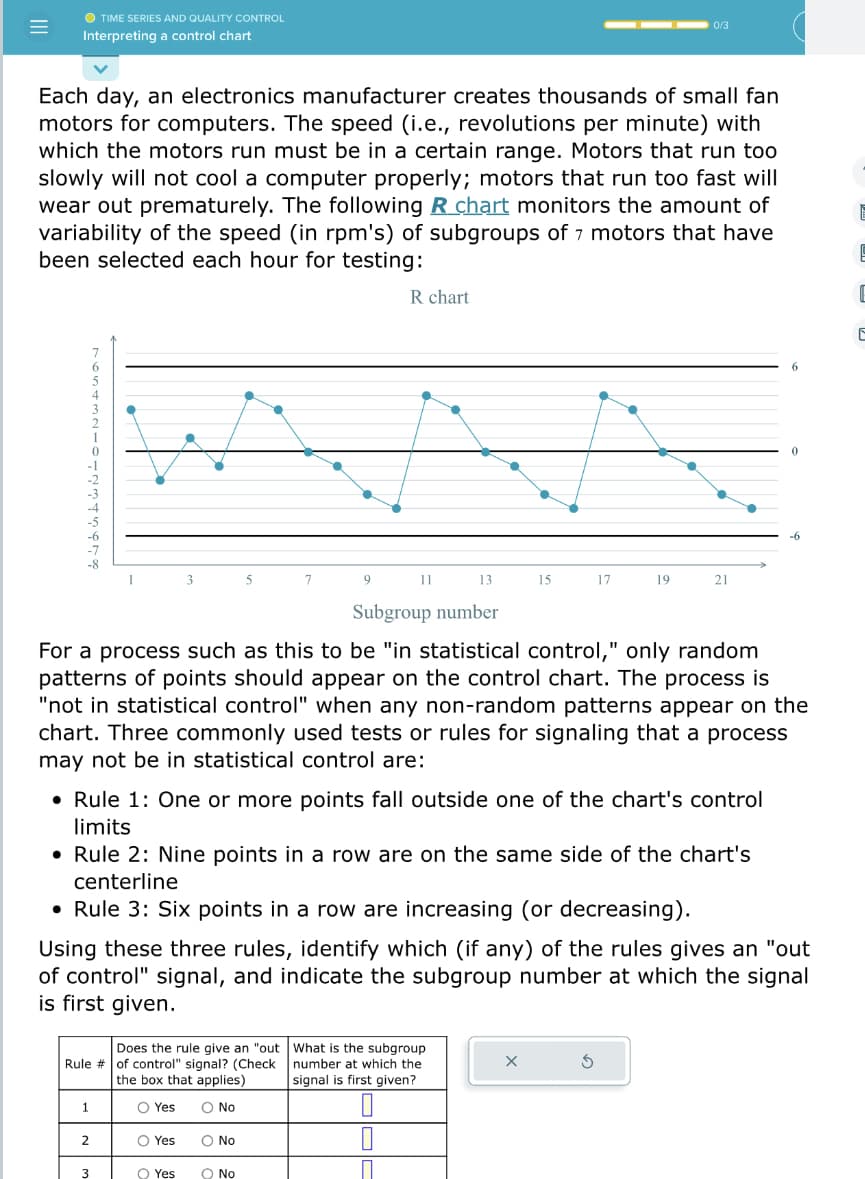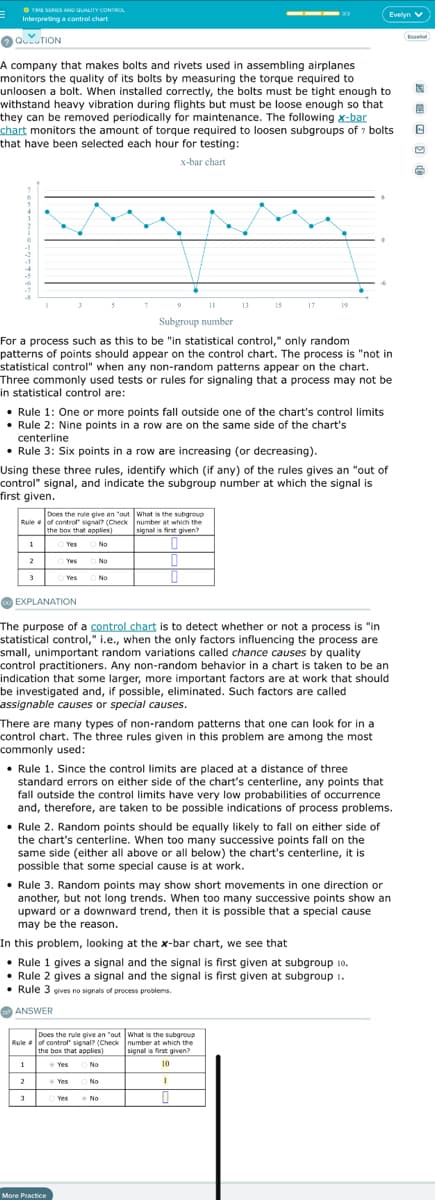Each day, an electronics manufacturer creates thousands of small fan motors for computers. The speed (i.e., revolutions per minute) with which the motors run must be in a certain range. Motors that run too slowly will not cool a computer properly; motors that run too fast will wear out prematurely. The following R chart monitors the amount of variability of the speed (in rpm's) of subgroups of 7 motors that have been selected each hour for testing: Does the rule give an "out Rule # of control" signal? (Check the box that applies) O Yes O No 1 9 2 R chart O Yes 11 O No 13 Subgroup number For a process such as this to be "in statistical control," only random patterns of points should appear on the control chart. The process is "not in statistical control" when any non-random patterns appear on the chart. Three commonly used tests or rules for signaling that a process may not be in statistical control are: • Rule 1: One or more points fall outside one of the chart's control limits • Rule 2: Nine points in a row are on the same side of the chart's centerline • Rule 3: Six points in a row are increasing (or decreasing). 15 17 Using these three rules, identify which (if any) of the rules gives an "out of control" signal, and indicate the subgroup number at which the signa is first given. What is the subgroup number at which the signal is first given? 0 0 □ 19 21 6
Each day, an electronics manufacturer creates thousands of small fan motors for computers. The speed (i.e., revolutions per minute) with which the motors run must be in a certain range. Motors that run too slowly will not cool a computer properly; motors that run too fast will wear out prematurely. The following R chart monitors the amount of variability of the speed (in rpm's) of subgroups of 7 motors that have been selected each hour for testing: Does the rule give an "out Rule # of control" signal? (Check the box that applies) O Yes O No 1 9 2 R chart O Yes 11 O No 13 Subgroup number For a process such as this to be "in statistical control," only random patterns of points should appear on the control chart. The process is "not in statistical control" when any non-random patterns appear on the chart. Three commonly used tests or rules for signaling that a process may not be in statistical control are: • Rule 1: One or more points fall outside one of the chart's control limits • Rule 2: Nine points in a row are on the same side of the chart's centerline • Rule 3: Six points in a row are increasing (or decreasing). 15 17 Using these three rules, identify which (if any) of the rules gives an "out of control" signal, and indicate the subgroup number at which the signa is first given. What is the subgroup number at which the signal is first given? 0 0 □ 19 21 6
Holt Mcdougal Larson Pre-algebra: Student Edition 2012
1st Edition
ISBN:9780547587776
Author:HOLT MCDOUGAL
Publisher:HOLT MCDOUGAL
Chapter7: Percents
Section7.2: Percents And Proportions
Problem 18E
Related questions
Question

Transcribed Image Text:=
OTIME SERIES AND QUALITY CONTROL
Interpreting a control chart
Each day, an electronics manufacturer creates thousands of small fan
motors for computers. The speed (i.e., revolutions per minute) with
which the motors run must be in a certain range. Motors that run too
slowly will not cool a computer properly; motors that run too fast will
wear out prematurely. The following R chart monitors the amount of
variability of the speed (in rpm's) of subgroups of 7 motors that have
been selected each hour for testing:
1
1
3
Does the rule give an "out
Rule # of control" signal? (Check
the box that applies)
O Yes
O No
2
3
O Yes
7
Yes
9
R chart
O No
11
• Rule 1: One or more points fall outside one of the chart's control
limits
O No
• Rule 2: Nine points in a row are on the same side of the chart's
centerline
• Rule 3: Six points in a row are increasing (or decreasing).
13
Subgroup number
For a process such as this to be "in statistical control," only random
patterns of points should appear on the control chart. The process is
"not in statistical control" when any non-random patterns appear on the
chart. Three commonly used tests or rules for signaling that a process
may not be in statistical control are:
15
Using these three rules, identify which (if any) of the rules gives an "out
of control" signal, and indicate the subgroup number at which the signal
is first given.
What is the subgroup
number at which the
signal is first given?
17
0/3
19
X
21
S
6
0
-6
E
E
E

Transcribed Image Text:TIME SERIES AND QUALITY CONTROL
Interpreting a control chart
QUYUTION
A company that makes bolts and rivets used in assembling airplanes
monitors the quality of its bolts by measuring the torque required to
unloosen a bolt. When installed correctly, the bolts must be tight enough to
withstand heavy vibration during flights but must be loose enough so that
they can be removed periodically for maintenance. The following x-bar
chart monitors the amount of torque required to loosen subgroups of 7 bolts
that have been selected each hour for testing:
x-bar chart
Does the rule give an "out
Rule of control signal? (Check
the box that applies)
Yes
No
No
No
For a process such as this to be "in statistical control," only random
patterns of points should appear on the control chart. The process is "not in
statistical control" when any non-random patterns appear on the chart.
Three commonly used tests or rules for signaling that a process may not be
in statistical control are:
• Rule 1: One or more points fall outside one of the chart's control limits
• Rule 2: Nine points in a row are on the same side of the chart's
centerline
• Rule 3: Six points in a row are increasing (or decreasing).
1
2
Using these three rules, identify which (if any) of the rules gives an "out of
control" signal, and indicate the subgroup number at which the signal is
first given.
Yes
Ⓒ Yes
11
Subgroup number
1
EXPLANATION
The purpose of a control chart is to detect whether or not a process is "in
statistical control," i.e., when the only factors influencing the process are
small, unimportant random variations called chance causes by quality
control practitioners. Any non-random behavior in a chart is taken to be an
indication that some larger, more important factors are at work that should
be investigated and, if possible, eliminated. Such factors are called
assignable causes or special causes.
Does the rule give an "out
Rule of control signal? (Check
the box that applies)
Yes
No
Yes
2
There are many types of non-random patterns that one can look for in a
control chart. The three rules given in this problem are among the most
commonly used:
3
13
What is the subgroup
number at which the
signal is first given?
15
• Rule 1. Since the control limits are placed at a distance of three
standard errors on either side of the chart's centerline, any points that
fall outside the control limits have very low probabilities of occurrence
and, therefore, are taken to be possible indications of process problems.
• Rule 2. Random points should be equally likely to fall on either side of
the chart's centerline. When too many successive points fall on the
same side (either all above or all below) the chart's centerline, it is
possible that some special cause is at work.
More Practice
17
19
• Rule 3. Random points may show short movements in one direction or
another, but not long trends. When too many successive points show an
upward or a downward trend, then it is possible that a special cause
may be the reason.
In this problem, looking at the x-bar chart, we see that
• Rule gives a signal and the signal is first given at subgroup 10.
Rule 2 gives a signal and the signal is first given at subgroup 1.
Rule 3 gives no signals of process problems.
ANSWER
Yes
No
No
What is the subgroup
number at which the
signal is first given?
10
Evelyn V
1
U
9
8
6
Expert Solution
This question has been solved!
Explore an expertly crafted, step-by-step solution for a thorough understanding of key concepts.
This is a popular solution!
Trending now
This is a popular solution!
Step by step
Solved in 3 steps

Recommended textbooks for you

Holt Mcdougal Larson Pre-algebra: Student Edition…
Algebra
ISBN:
9780547587776
Author:
HOLT MCDOUGAL
Publisher:
HOLT MCDOUGAL

Mathematics For Machine Technology
Advanced Math
ISBN:
9781337798310
Author:
Peterson, John.
Publisher:
Cengage Learning,

College Algebra (MindTap Course List)
Algebra
ISBN:
9781305652231
Author:
R. David Gustafson, Jeff Hughes
Publisher:
Cengage Learning

Holt Mcdougal Larson Pre-algebra: Student Edition…
Algebra
ISBN:
9780547587776
Author:
HOLT MCDOUGAL
Publisher:
HOLT MCDOUGAL

Mathematics For Machine Technology
Advanced Math
ISBN:
9781337798310
Author:
Peterson, John.
Publisher:
Cengage Learning,

College Algebra (MindTap Course List)
Algebra
ISBN:
9781305652231
Author:
R. David Gustafson, Jeff Hughes
Publisher:
Cengage Learning